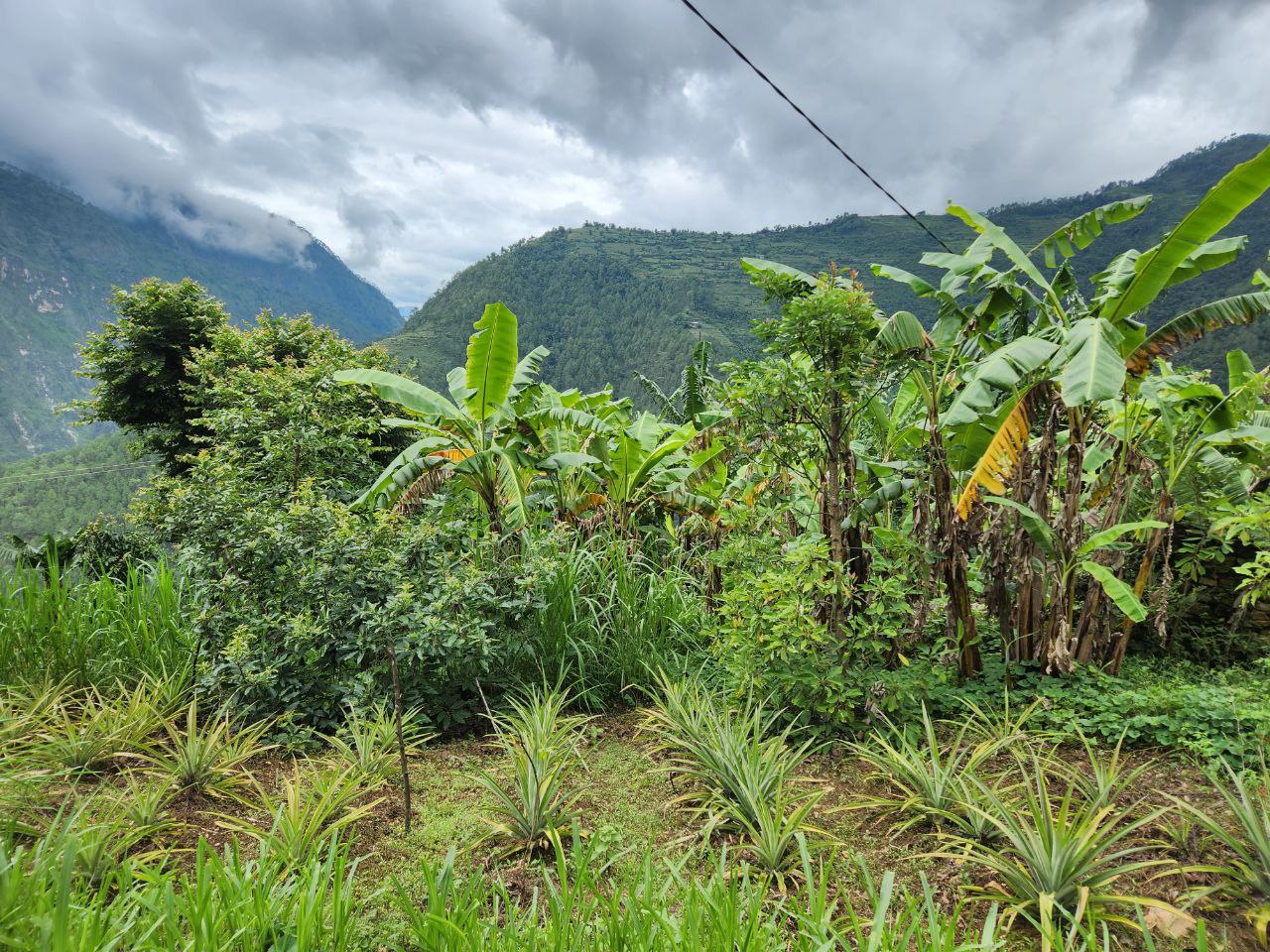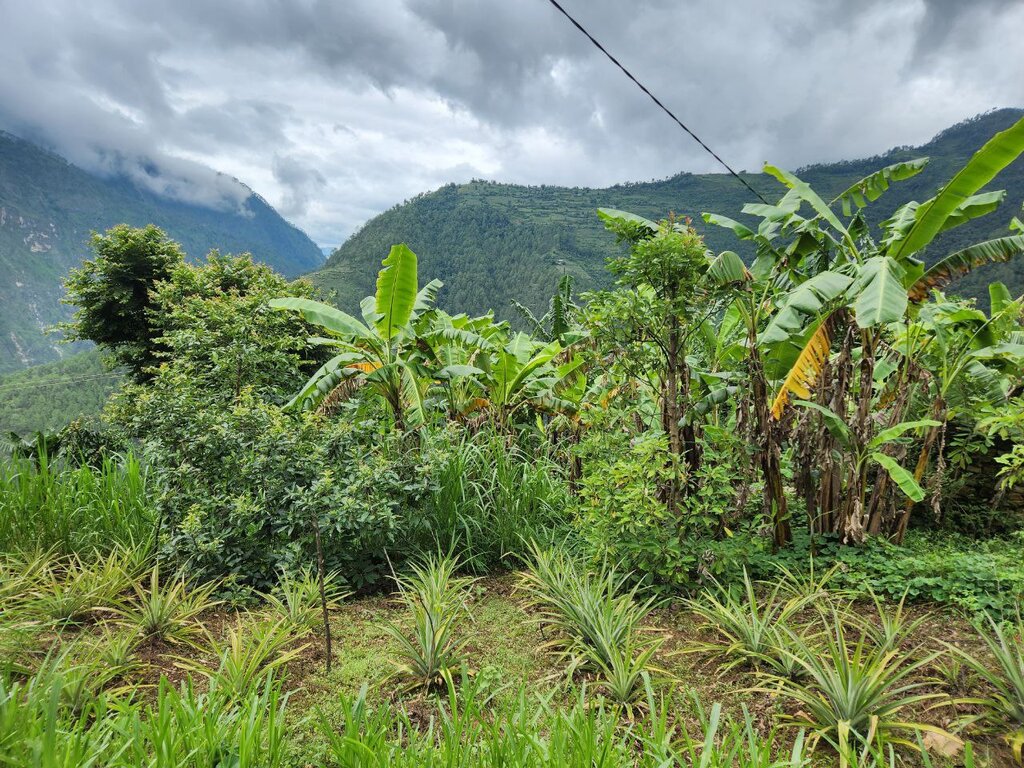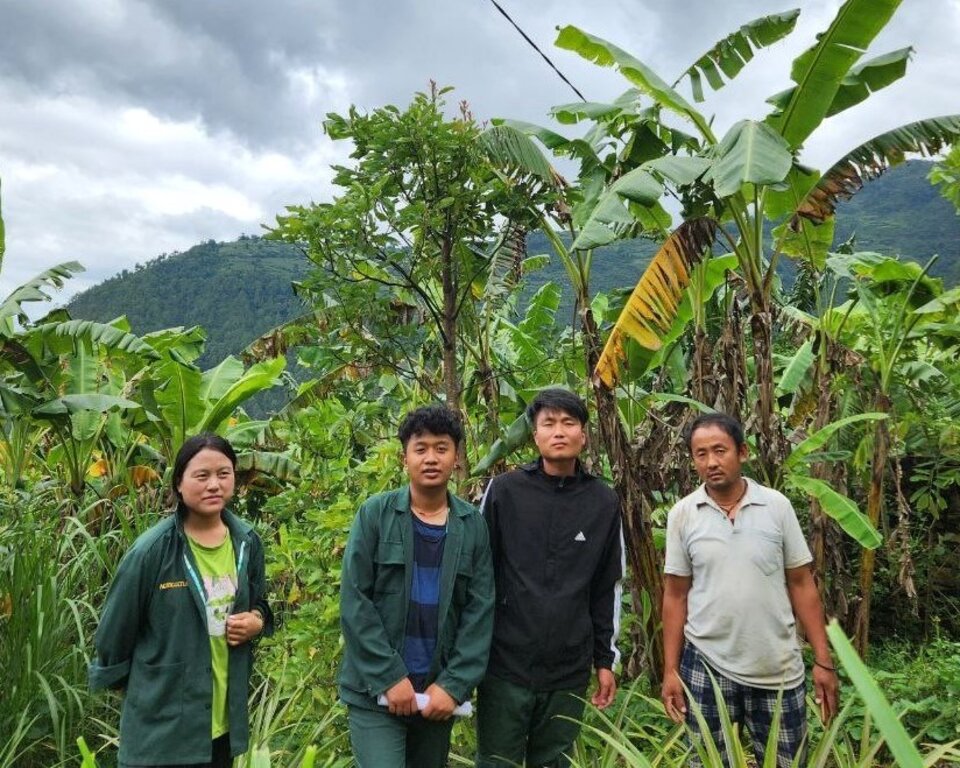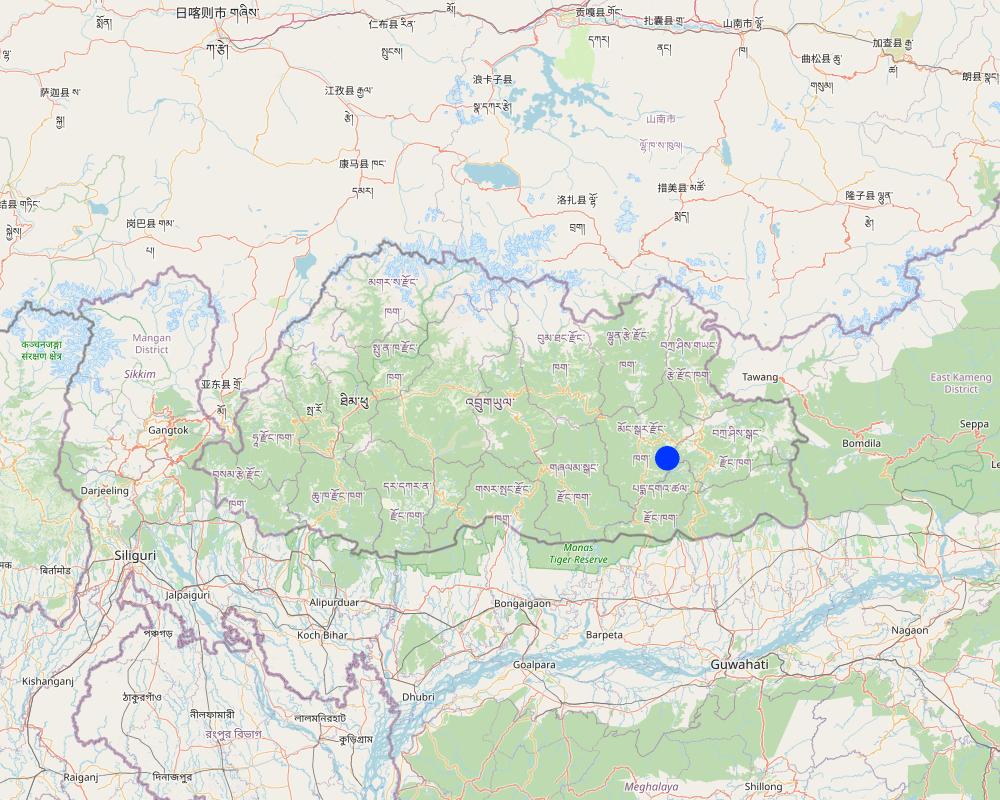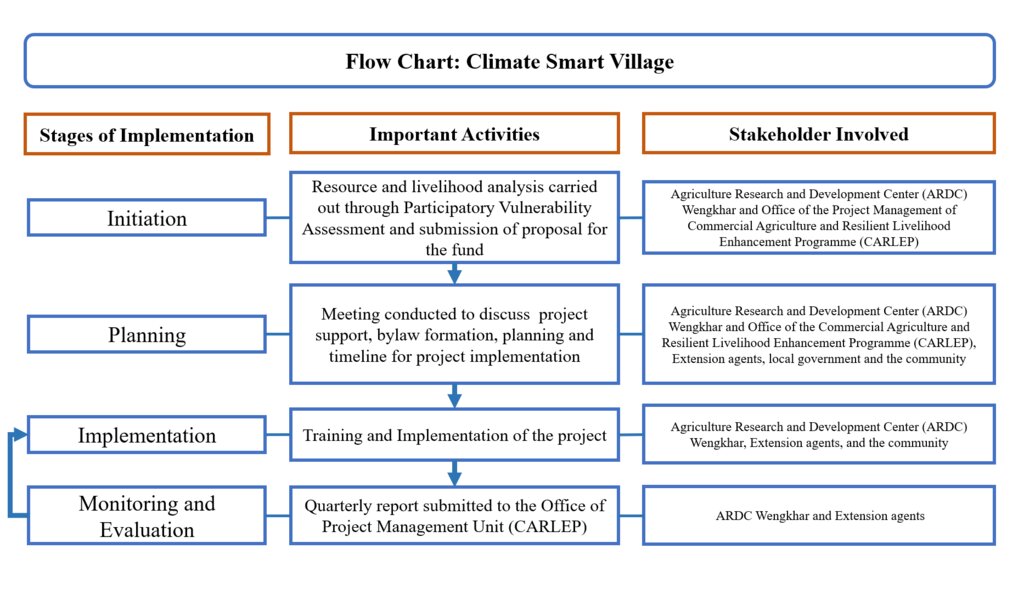Climate-Smart Village Approach [Butão]
- Criação:
- Atualização:
- Compilador/a: ONGPO LEPCHA
- Editor: –
- Revisores: William Critchley, Rima Mekdaschi Studer, Joana Eichenberger
Namshi Thuendrel Gi Yue (གནམ་གཤིས་མཐུན་འབྲེལ་གྱི་གཡུས།)
approaches_6852 - Butão
Veja as seções
Expandir tudo Recolher tudo1. Informação geral
1.2 Detalhes do contato das pessoas capacitadas e instituições envolvidas na avaliação e documentação da abordagem
Pessoa(s) capacitada(s)
usuário de terra:
Yangki Karma
77211775
Ngaru-Pongtang village
Ngaru-Pongtang village, Thangrong gewog (block), Mongar Dzongkhag (district), Bhutan
Butão
usuário de terra:
Lhaden Sanga
77625788
Ngaru-Pongtang village
Ngaru-Pongtang village, Thangrong gewog, Mongar Dzongkhag, Bhutan
Butão
usuário de terra:
Lhendup
17526138
Ngaru-Pongtang village
Ngaru-Pongtang village, Thangrong gewog, Mongar Dzongkhag, Bhutan
Butão
Nome do projeto que facilitou a documentação/avaliação da Abordagem (se relevante)
Strengthening national-level institutional and professional capacities of country Parties towards enhanced UNCCD monitoring and reporting – GEF 7 EA Umbrella II (GEF 7 UNCCD Enabling Activities_Umbrella II)Nome da(s) instituição(ões) que facilitou(ram) a documentação/avaliação da Abordagem (se relevante)
National Soil Services Centre, Department of Agriculture, Ministry of Agriculture & Livestock (NSSC) - Butão1.3 Condições em relação ao uso da informação documentada através de WOCAT
Quando os dados foram compilados (no campo)?
15/07/2023
O/a compilador/a e a(s) pessoa(s) capacitada(s) aceitam as condições relativas ao uso de dados documentados através da WOCAT:
Sim
1.4 Referência ao(s) questionário(s) sobre tecnologias da GST
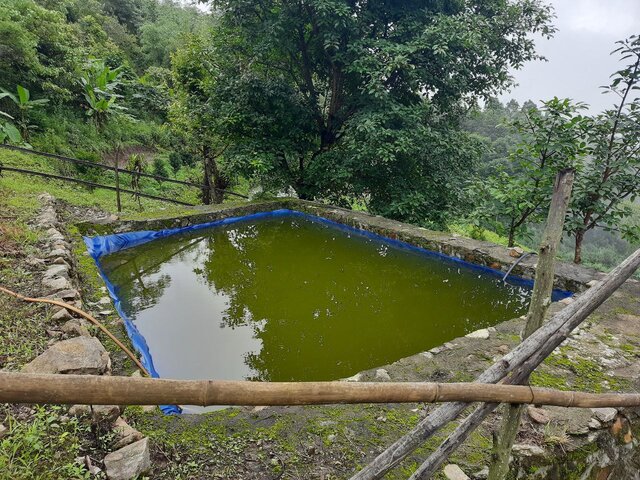
Low-Cost Plastic-Lined Water Harvesting Pond [Butão]
Low-cost plastic-lined water harvesting ponds collect and store rain and overland flow water for agricultural and domestic purposes in the dry season. They are both economic and efficient.
- Compilador/a: Nima Dolma Tamang
2. Descrição da abordagem de GST
2.1 Descrição curta da abordagem
Climate change has become inevitable, and there is a need to address this impending danger. In the Climate-Smart Village (CSV) approach, land users in Ngaru-Pongtang have implemented several technologies and innovations to address climate change impacts, and the programme has worked with 50 households on a total area of 137 acres (55 ha).
2.2 Descrição detalhada da abordagem
Descrição detalhada da abordagem:
This approach focused on transforming Ngaru-Pontang into a Climate-Smart Village (CSV) with actions that also contribute to mitigating climate change. The programme has worked with 50 households on a total area of 137 acres (55 ha). The approach included a participatory vulnerability assessment, and extensive training and education for the land users. They were equipped with skills, technologies, and innovative practices related to climate-smart agriculture (CSA). Additionally, the approach emphasized collaborative efforts, working closely with community members to foster better engagement and cooperation.
The primary objectives of the approach were to transform Ngaru-Pontang village into a CSV and thus effectively address the challenges posed by climate change. To achieve these goals, the approach employed various methods. It involved meetings with the community members, vulnerability assessment, fostering collaboration between the community, Agriculture Research and Development Centre (ARDC) Wengkhar, and Commercial Agriculture and the Resilient Livelihood Enhancement Programme (CARLEP). The community members received comprehensive training and attended workshops on climate-smart agriculture practices.
The implementation of the approach adopted the following stages:
1. Resource and livelihood analysis carried out through a Participatory Vulnerability Assessment.
2. Based on the findings from the above assessment, a project proposal was submitted to secure funding.
3. Subsequently, discussions were held with the community members, the extension agent, and the local government to ensure collective agreement and support.
4. A detailed plan with a timeline was developed to guide project implementation and monitoring.
5. Training and workshops on CSA practices were conducted by the ARDC and the extension agent, empowering the community members to take charge of project implementation and ensure sustainability.
Key stakeholders involved in the approach included:
1. ARDC Wenkhar, which led the implementation of the project, facilitated the training and workshops, provided technical assistance, and monitored the programme's progress.
2. The Gewog administration and the extension agent played crucial roles by offering support and assistance in implementing climate-smart agriculture practices in the field.
3. The community members actively participated in various program activities, playing a pivotal role in driving the project forward.
4. The Commercial Agriculture and Resilient Livelihood Enhancement Programme (CARLEP) acted as the funding agency.
The key CSA practices implemented through this approach are soil fertility improvement technologies (composting through use of FYM and bio-slurry, vermicomposting; liquid manure, biochar, Bhutan Agri-Microbial Solution (BAMS) and hedgerow plantations), community solar-electric fencing, heat and drought tolerant crops (spring paddy, soybean, avocados, mangoes and pineapples), biogas installations and establishment of weather station.
The implementation of CSA interventions has resulted in a wide range of impacts on livelihoods, income, and enhanced climate resilience. The diversification of crops, electric fencing, and improvement in irrigation have enabled farmers to expand their cultivation area thereby directly enhancing crop production and cash income. Similarly, the integration of improved livestock farming systems along with crops and the installation of biogas plants have reduced impacts on natural resources. Farmers have gained knowledge and exposure to different climate-smart agriculture practices. The only negative impact of the measures has been extra damage to crops by wild animals.
2.3 Fotos da abordagem
2.5 País/região/locais onde a abordagem foi aplicada
País:
Butão
Região/Estado/Província:
Mongar Dzongkhag
Especificação adicional de localização:
Ngaru-Pongtang village, Thangrong gewog
Map
×2.6 Datas de início e término da abordagem
Indique o ano de início:
2016
Ano de término (caso a abordagem não seja mais aplicada):
2021
Comentários:
The establishment of the CSV was between 2016 to 2021, but activities continue to progress despite the completion of the project.
2.7 Tipo de abordagem
- Baseado em projeto/programa
2.8 Principais metas/objetivos da abordagem
The main objective of the approach was to establish Ngaru-Pongtang as a CSV and showcase different CSA practices geared towards combating, mitigating and addressing climate change impacts, which can be replicated to other gewogs and Dzongkhags.
2.9 Condição que propiciam ou inibem a implementação de tecnologia/tecnologias aplicada(s) segundo a abordagem
Disponibilidade/acesso a recursos e serviços financeiros
- Propício
Community members were provided with equipment and planting materials through project's support.
Quadro institucional
- Propício
Local government and gewog agriculture extension agent were involved during the training, seminars and the implementation of the project activities to ensure ownership and sustainability of the project.
Colaboração/coordenção de atores
- Propício
Stakeholders (ARDC Wengkhar, local government and community members) participated and cooperated together during the entire project period.
Conhecimento sobre GST, acesso a suporte técnico
- Propício
ARDC Wengkhar provided regular training and workshops with regard to climate-smart agriculture, good agricultural practices and sustainable land management for the successful implementation of the project.
Mercados (para comprar entradas, vender produtos) e preços
- Propício
ARDC Wengkhar has facilitated agricultural marketing by linking up the community with Bhutan Agro-Industry located at Lingmethang, Mongar.
3. Participação e papel das partes interessadas envolvidas
3.1 Partes interessadas envolvidas na abordagem e seus papéis
- Usuários de terra/comunidades locais
Ngaru-Pongtang community
As a beneficiary, participated actively in the planning and implementation of the project activities, ensuring the project was successful and beneficial to them.
- Pesquisadores
ARDC Wenkhar
Led the implementation of the project; facilitated the training and the workshops; provided technical assistance to the program; and monitored the progress of the program.
- Governo local
Gewog administration and gewog agriculture office
They provided administrative support and collaborated with other stakeholders in successful designing and implementation of the project activities.
- Organização internacional
International Fund for Agricultural Development (IFAD)
IFAD provided financial assistance through its Commercial Agriculture and Resilient Livelihood Enhancement Programme (CARLEP)
3.2 Envolvimento do usuários de terra/comunidades locais nas diferentes fases da abordagem
| Envolvimento do usuários de terra/comunidades locais | Especifique quem estava envolvido e descreva as atividades | |
|---|---|---|
| Iniciação/motivação | Passivo | The local community members were informed verbally and through community meeting about the project. |
| Planejamento | Participativo | ARDC Wengkhar, Thangrong gewog administration, gewog agriculture extension agent and the community members came together and discussed the way forward for the project. |
| Implementação | Participativo | Community members were provided with training and workshops on climate-smart agriculture and related agricultural skills. After the training and demonstrations, land users were divided into groups and made to apply these skills in their field. |
| Monitoramento/avaliação | Participativo | Monitoring is being sporadically conducted by ARDC Wengkhar and the gewog agriculture extension agent, but it is left to the land users to monitor their own fields. |
3.3 Fluxograma (se disponível)
Descrição:
The flowchart was created based on the information provided by the community members
Autor:
Ongpo Lepcha
3.4 Decisão sobre a seleção de tecnologia/tecnologias de GST
Especifique quem decidiu sobre a seleção de tecnologia/tecnologias a serem implementadas:
- Principalmente especialistas em GST, após consulta com usuários da terra
Explique:
ARDC Wenkhar was responsible for deciding on what technologies and innovations to apply in the community, however, this was done based on consultation and discussions with the community members of Ngaru-Pongtang.
Especifique em que base foram tomadas as decisões:
- Avaliação de conhecimento bem documentado de GST (tomada de decisão baseada em evidências)
- Consultation with the community members
4. Suporte técnico, reforço das capacidades e gestão do conhecimento
4.1 Reforço das capacidades/ formação
Foi oferecida formação aos usuários da terra/outras partes interessadas?
Sim
Especifique quem foi capacitado:
- Usuários de terra
Caso seja relevante, especifique gênero, idade, status, etnia, etc.
Both males and females were trained.
Tipo de formação:
- Agricultor para agricultor
- Áreas de demonstração
- Reuniões públicas
Assuntos abordados:
The topics covered included climate-smart agriculture, sustainable land management, and good agricultural practices.
Comentários:
The capacity building was conducted by the Agriculture Research Development Center (ARDC) in Wengkhar and the participants included community members. The program was coordinated, facilitated, and implemented by an extension agent in collaboration with Local Government and beneficiaries.
4.2 Serviço de consultoria
Os usuários de terra têm acesso a um serviço de consultoria?
Sim
Especifique se foi oferecido serviço de consultoria:
- nas áreas dos usuários da terra
Descreva/comentários:
ARDC Wengkhar and the agricultural extension agent provided all the technical advice and assistance required by the community members.
4.3 Fortalecimento da instituição (desenvolvimento organizacional)
As instituições foram fortalecidas ou estabelecidas através da abordagem?
- Sim, moderadamente
Especifique a que nível (níveis) as instituições foram fortalecidas ou estabelecidas:
- Local
Descreva instituição, papéis e responsabilidades, membros, etc.
The local government was involved in the project from start till end, which enhanced their understanding and capacity to initiate and replicate similar projects in other villages.
Especifique o tipo de apoio:
- Reforço das capacidades/ formação
- Technical assistance
Dê mais detalhes:
Local government officials were engaged in the capacity building programs implemented for the community and also provided technical assistance as and when required.
4.4 Monitoramento e avaliação
Monitoramento e avaliação são partes da abordagem?
Sim
Comentários:
ARDC Wenkhar and the agriculture extension agent sporadically conducted monitoring and evaluation. However, the local land users are given the full responsibility to monitor their own fields and seek assistance when required.
Caso afirmativo, esta documentação é destinada a ser utilizada para monitoramento e avaliação?
Não
4.5 Pesquisa
A pesquisa foi parte da abordagem?
Sim
- Vulnerability Assessment
Dê mais detalhes e indique quem realizou a pesquisa:
ARDC Wengkhar conducted a resource and livelihoods analysis through vulnerability assessment before designing and implementng the project in the community.
5. Financiamento e apoio material externo
5.1 Orçamento anual para o componente de GST da abordagem
Indique o orçamento anual para o componente de GST da abordagem em US$:
55920,82
Comentários (p. ex. principais fontes de recursos/principais doadores):
The funding was through Commercial Agriculture and Resilient Livelihoods Enhancement Programme (CARLEP) funded by International Fund for Agricultural Development (IFAD).
5.2 Apoio financeiro/material concedido aos usuários da terra
Os usuários da terra receberam apoio financeiro/material para a implementação de tecnologia/tecnologias?
Sim
Caso afirmativo, especifique tipo(s) de apoio, condições e fornecedor(es):
Material inputs such as seeds and seedlings, organic fertilizers, sprinkler pipes, and green shade net were provided through the project.
5.3 Subsídios para entradas específicas (incluindo mão-de-obra)
- Equipamento
| Especifique quais entradas foram subsidiadas | Em que medida | Especifique os subsídios |
|---|---|---|
| Maquinário | Parcialmente financiado | Sprinkler pipes and green shade nets |
- Agrícola
| Especifique quais entradas foram subsidiadas | Em que medida | Especifique os subsídios |
|---|---|---|
| Sementes | Totalmente financiado | Seeds and saplings |
| Fertilizantes | Totalmente financiado | Organic fertilizers |
Se a mão-de-obra pelos usuários da terra foi uma entrada substancial, isso foi:
- Voluntário
Comentários:
The project beneficiaries arranged their own family labour or through informal labour exchange model.
5.4 Crédito
Foi concedido crédito segundo a abordagem para atividades de GST?
Não
5.5 Outros incentivos ou instrumentos
Foram utilizados outros incentivos ou instrumentos para promover a implementação das tecnologias de GST?
Não
6. Análise de impactos e declarações finais
6.1 Impactos da abordagem
A abordagem concedeu autonomia aos usuários locais de terra, melhorou a participação das partes interessadas?
- Não
- Sim, pouco
- Sim, moderadamente
- Sim, significativamente
The project built capacity of the land users and are able to implement and monitor project activities in their own fields.
A abordagem auxiliou os usuários da terra a implementar e manter as tecnologias de GST?
- Não
- Sim, pouco
- Sim, moderadamente
- Sim, significativamente
Conducting training and workshops were part of the approach and therefore this made implementing and maintaining the sustainability of the project possible.
A abordagem aprimorou o conhecimento e as capacidades dos usuários da terra para implementar a GST?
- Não
- Sim, pouco
- Sim, moderadamente
- Sim, significativamente
The training and workshop helped provide knowledge and skills regarding sustainable land management and climate smart agriculture practices.
A abordagem aprimorou o conhecimento e as capacidades de outras partes interessadas?
- Não
- Sim, pouco
- Sim, moderadamente
- Sim, significativamente
The project enabled local government to enhance their knowledge and capacity through direct engagement in the training program and in the implementation of the project activities in the field.
A abordagem concedeu autonomia aos grupos social e economicamente desfavorecidos?
- Não
- Sim, pouco
- Sim, moderadamente
- Sim, significativamente
The project benefited all the community members equally disregarding of their background.
A abordagem resultou em segurança alimentar aprimorada/nutrição melhorada?
- Não
- Sim, pouco
- Sim, moderadamente
- Sim, significativamente
The climate-smart agriculture practices have improved the agricultural production through crop diversification, electric fencing and irrigation water improvement.
A abordagem melhorou o acesso aos mercados?
- Não
- Sim, pouco
- Sim, moderadamente
- Sim, significativamente
ARDC Wengkhar and the local government have facilitated the market by linking the community with Bhutan Agro-industry for processing.
A abordagem aprimorou a capacidade dos usuários da terra de adaptar-se a mudanças climáticas/extremos e atenuar os desastres relacionados com o clima?
- Não
- Sim, pouco
- Sim, moderadamente
- Sim, significativamente
Land users were trained on climate-smart agriculture and most importantly the land users have implemented climate smart agriculture practices in their fields which will definitely help build their capacity to adapt to the climate change.
6.2 Principal motivação dos usuários da terra para implementar a GST
- Produção aumentada
The diversification of crops (drought resistant crop varieties), improvement of irrigation water and electric fencing have helped to expand cultivation and enhance production.
- Lucro (lucrabilidade) aumentado, melhora da relação custo-benefício
Facilitation of market linkage wth Bhutan Agro-Industry has provided assured market for the local produce.
- melhoria dos conhecimentos e aptidões de GST
The community members have been trained on SLM and CSA practices.
- Adapt and mitigate climate change
CSA practices including SLM has minimised soil erosion, increased soil organic matter, conserved soil moisture and improved the overall soil health.
6.3 Atividades de sustentabilidade de abordagem
Os usuários da terra podem manter o que foi implementado através da abordagem (sem apoio externo)?
- Sim
Caso afirmativo, descreva como:
The land users have built their capacity, improved their production and cash income which should enable them to sustain the project activities.
6.4 Pontos fortes/vantagens da abordagem
| Pontos fortes/vantagens/oportunidades na visão do usuário da terra |
|---|
| Capacity building and technical assistance on CSA and SLM were provided. |
| Gained knowledge and skills on CSA practices |
| Were able to increase crop production through CSA interventions |
| Were provided with an assured market for their produce |
| Pontos fortes/vantagens/oportunidades na visão do/a compilador/a ou de outra pessoa capacitada |
|---|
| Built human and natural capital through capacity building and implementation of CSA practices. |
| Enhanced community resilience to climate change impacts |
6.5 Pontos fracos, desvantagens da tecnologia e formas de superá-los
| Pontos fracos/desvantagens/riscos na visão do usuário da terra | Como eles podem ser superados? |
|---|---|
| The approach didn't address the pest problem, specifically the vertebrate pest adequately. | Explore additional funding to support electric fencing and if possible chain link fencing. |
| Farmers' hesitance to adopt technology. | Create adequate awareness prior to actual design an implementation of the project. |
7. Referências e links
7.1 Métodos/fontes de informação
- entrevistas com usuários de terras
3 individuals
7.2 Referências às publicações disponíveis
Título, autor, ano, ISBN:
Saanogo, D, Sail, M., & Camara, B. A.. (2020). The climate-smart village approach: putting communities at the heart of restoration. Tropenbos International, Wageningen.
Disponível de onde? Custos?
https://www.tropenbos.org/file.php/2385/etfrn-news-60-sanogo-the-climate-smart-village-approach.pdf
Título, autor, ano, ISBN:
Aggarwal, P. K., Jarvis, A., Campbell, B. M., & Zougmore, R. (2018). The climate-smart village approach: Framework of an integrative strategy for scaling up adaptation options in agriculture. Ecology and Society, 23(1).
Disponível de onde? Custos?
https://www.researchgate.net/publication/322765373_The_climate-smart_village_approach_Framework_of_an_integrative_strategy_for_scaling_up_adaptation_options_in_agriculture
7.3 Links para informação relevante que está disponível online
Título/ descrição:
The climate smart villages approach
URL:
https://www.grida.no/resources/4928
Título/ descrição:
THE CLIMATE-SMART VILLAGE APPROACH: FRAMEWORK OF AN INTEGRATIVE STRATEGY FOR SCALING UP ADAPTATION OPTIONS IN AGRICULTURE
URL:
https://ccafs.cgiar.org/resources/publications/climate-smart-village-approach-framework-integrative-strategy-scaling
Links e módulos
Expandir tudo Recolher tudoLinks

Low-Cost Plastic-Lined Water Harvesting Pond [Butão]
Low-cost plastic-lined water harvesting ponds collect and store rain and overland flow water for agricultural and domestic purposes in the dry season. They are both economic and efficient.
- Compilador/a: Nima Dolma Tamang
Módulos
Não há módulos


